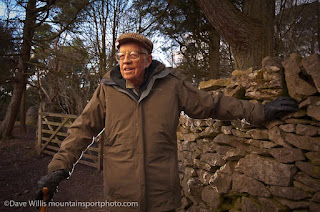My reason for meeting with and photographing Eric was simply that BBC CountryFile magazine would be honouring Eric's selfless labour at the annual awards ceremony so we needed a shot for the mag. A simple headshot would do. But I don't do simple headshots. I do portraits and I like to think that I do them creatively - I certainly try to.
My thinking on this was fairly straightforward because I knew I wouldn't have a lot of time with Eric (he has a busy schedule!) and he wasn't able to walk all that far. I wanted to use an overhead flash with a reflecting umbrella as a key light and a second speedlight behind, low down at ground level as a kicker or "rim-light".
The key light would be an Nikon SB600/Pocket Wizard TT5 Flex mounted on an umbrella clamp on the end of an old Unilock (Benbo-style) tripod. Why the tripod rather than a lightstand? For the simple reason that I wanted to get the lighting rig high and overhead of Eric. I've played around with lighting at all kinds of different angles and positions for portraits and I'm happiest flying my flash right overhead of my subject. The problem is how to get it up there. A standard lightstand will only ever get you light from the side - not overhead - and anyway even if you got it high enough, the stand itself would be in the shot. The normal solution would be a C stand, overwise know as a Century stand which is basically a big, heavy piece of kit with an extending boom arm, developed for the film industry at Century studios. Except that I don't have one. Yet. But I do have an old Unilock (and a big Benbo) which also have extending columns that can act as booms. I replaced the column on the Unilock with the column from an old standard 8ft lightstand. Now I had a boom-stand and better still, it had adjustable tripod legs which are much more stable on rough ground.
I quickly put up my speedlight overhead and slightly to the left of Eric with a silver-lined refelecting umbrella. Fortunately there was no wind as such in the woods. An umbrella outdoors is a liability at the best of times. With wind, it turns into a sail! A sail attached to 500 quids worth of flash and Pocket Wizard is not ideal.

Now to add the kicker. The rear rim-light flash serves two purposes. First it seperates the subject from the background, which it really needed because of all the muted, dark tones of the wall, the trees, Erics' clothing and so on. And second, it highlights the wall - which is an integral part of the story here. I put an SB28 in manual mode (on half power I think) with a second Pocket Wizard Flex TT5 trigger and we're ready to shoot.
I generally use my flash with 1/4 CTO gels attached to get a warmer light. So I thought about cooling down the ambient white balance a bit to enhance the blue sky and create a bit of colour contrast between ambient and flash light. It worked Ok but really it needs stronger CTO, maybe 1/2 or 1 stop CTO to really work well at midday. Even so, the sky came out strongly (as did Erics blue socks!)
I did three or four different angles fairly quickly with Eric before he was hailed by a passing walker, a local who recognised the veteran dry stone waller and struck up a good natured conversation, which gave me a chance to assess our progress. Actually, I was pretty much done. We had spent 10 minutes setting up, 5-10 minutes shooting and I thought I had my quick headshot in the bag. I duly sent the pix to Countryfile, they liked them. Two weeks later, I get a call from the National Trust's pr office. They've seen the shot, can they use it themselves? Well, there you go. You spend that little bit extra time and effort, make a portrait instead of a headshot and reap the rewards. it's all good.


No comments:
Post a Comment